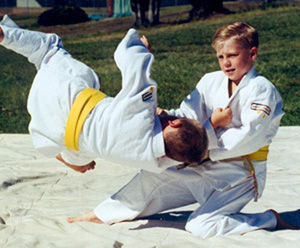What is Jujitsu?
Jujitsu is a truly non aggressive self defence style that emphasizes escape, leverage, body mechanics and the use of balance to avoid fighting. Where karate teaches one how to be an efficient fighter, exchanging blow for blow, jujitsu teaches the art of controlled escape. Karate practitioners punch and kick, thus engaging in the fight. A jujituska will not respond unless physically attacked and will do so by means of escape, joint lock, takedown or throw. Thus ending the fight almost before it has begun.
What will be taught?
Students will learn the rudiments of tumbling, rolling and the proper way in which to fall. The beginning student will be taught balance and stance work as well as the mechanics of leverage and escape, anatomy and joint manipulation, and simple takedowns. Only after the student has mastered the art of falling will s/he be taught the art of throwing. Safety is always stressed.
What about discipline?
Jujitsu is an honourable art that teaches the maxims of the social conscience. Mutual respect and co-operation are stressed as well as the internal discipline of self control. Parents may be pleased to find that values taught in jujitsu augment and reinforce those taught at home.
How does Jujitsu differ from Judo?
I hesitate to address this question because the answer has proven to be rather controversial and I am far from an expert on the subject. However, here is a much simplified attempt.
Ju means gentle, Jitsu means art and Do means way. As such Ju Jitsu means gentle art and Ju Do means gentle way. Some techniques that could be described as Jujitsu date back some 3000 years while the sport of Judo began approximately 150 years ago. Judo makes use of the same principles and techniques as Jujitsu with some changes in application and language. Judo is a competitive sport and as such is governed by rules and regulations to define scoring, penalizing and disqualification of participants. Many Jujitsu techniques are not permitted in Judo because they lie outside the areas defined as the sport. Judo continues to evolve and from time to time judgements are made concerning the use of new variations and old techniques. These techniques are sometimes accepted while others are banned from use. Jujitsu considers all new and old variations as potentially useful in a self defence situation. In Japan, Judo has displaced Jujitsu in availability and popularity.
How does Jujitsu differ from Karate?

Uki Otoshi
Jujitsu is based on the principles of leverage and balance. When an opponent attacks, s/he will invariably be strong in one direction and weak in others. Jujitsu exploits these weaknesses to off balance and redirect the energy of the opponent's attack. This redirected energy is then used to escape from or seize the opponent and/or throw them to the ground. Note the photo above. The technique displayed in the photo is known as Uki Otoshi and is used when the attacker has grabbed or punched at the defender. The opponent expends energy and expects some level of resistance of same. That resistance is yielded in such a way to exaggerate the energy loss and the opponent loses their balance. The opponent is then easily toppled in that moment and brought to the ground. Once on the ground, further techniques can be used to bind and lock the opponent rendering them incapable of further attack. Karate is comprised of various styles. Some of the more popular styles are Tae Kwon Do, Kempo, Kung-Fu and Shotokan. Karate is based on many principles that employ the use of a retaliatory sequence of moves with either the hand or foot. Stance, foot-work, kicking, blocking and striking with the open or closed hand are emphasized. Sequences of moves are practised and memorize as forms (katas) and are taught as a way of cataloguing and remembering techniques learned in Karate.
What about Aikido?
Again the Do in Aikido means way and in some instances one can find someone teaching Aikijitsu. Over time, as people moved and arts evolved, principles and techniques from the arts were exchanged and modified. Aikido is a variant and synthesis of Jujitsu and Karate. It employs the use of balance and leverage to cause the opponent to fall or otherwise lose the effectiveness of their attack. Aikido, like Karate uses stance, foot-work, kicking and punching to further disable the attacker. Note: At present, all arts, to some extent, have exchanged and incorporated principles and techniques of differing arts.
More questions can be addressed on the web site of
The American Judo
and Jujitsu Federation